Navigation menu
- Mission Logs
- Chronologies
- Library Computer

U.S.S. Voyager NCC-74656
The Federation Starship Voyager, an Intrepid class vessel, was launched in 2370 under the command of Captain Kathryn Janeway , and was stranded in the Delta Quadrant —some 70,000 light years from Earth —by an entity known as the Caretaker on SD 48316.1 . Captain Janeway invited the similarly stranded crew of a destroyed Maquis vessel —which Voyager was pursuing when it was pulled across the galaxy—to join the crew, and asked the Maquis commander, Chakotay , to serve as her first officer , succeeding the late Lieutenant Commander Cavit , who died in the violent transgalactic transit, while other members of the Maquis crew filled the positions of other Voyager crew members who had perished, [1] including B'Elanna Torres , who took over as Voyager's chief engineer. [2]
- 1 Construction
- 2 Adaptations
- 3.1 Ships Named Voyager
- 3.2 Intrepid class vessels
- 4 Notes and References
Construction
U.S.S. Voyager ( VOY 107 )
Voyager's computer core installation took place on SD 47833.9 ; it was fast-tracked to follow the U.S.S. Intrepid NCC-74600 and the U.S.S. Bellerophon NCC-74705 by only three months. With assembly and internal systems checks completed, the official launching occurred at Earth Station McKinley on SD 48039.7 , [3] though primary construction was completed at Utopia Planitia Fleet Yards . [4] A 15-day series of impulse tests, which verified the integrity of the vessel and systems operation at sublight velocities, culminated in Voyager accelerating to Warp 1.03 with the U.S.S. Hauck flying formation for engineering support and emergency backup. Three weeks of warp flight tests added to the Intrepid class knowledge base and insured that Voyager's computer cores and bio-neural gel packs could receive operational programming loads for deployment in the Alpha Quadrant . Voyager received her first patrol assignment on SD 48184.4 . All in-flight systems data continued to be transmitted to Starfleet Command for evaluation, along a range of velocities from inertial stop to Warp 9.986 for distances up to 45 light years , with subspace com relays handling the encrypted telemetry loop. Subsequent operational missions validated the effectiveness of the class design and upgrades from previous Starfleet vessels. Voyager would provide only a few months of usable data before its disappearance in the Delta Quadrant . However, the stored information and lessons learned by its crew proved invaluable upon her return, a testament to the designers and engineers who stood upon the shoulders of giants to build her. [3]
Adaptations
Stranded in the Delta Quadrant, away from all the support facilities that Starfleet would have provided, Voyager's the crew was, by necessity, forced to make alterations to their vessel. These changes were designed to make the ship as self-sufficient as possible and to make it a suitable home for the journey back to the Alpha Quadrant, which was expected to last decades. Their problems were compounded because, unlike a Galaxy class starship, Voyager was not designed for extended missions. [5]
Shortly after its arrival in the Delta Quadrant, Voyager's engine efficiency began to decrease because of all the added demands being made upon the systems. Lieutenant Torres was able to realign the lateral plasma conduit without causing an overload, and this helped, but the engineering staff's attempts to convert power from the holodecks' independent reactors were unsuccessful. To conserve power, all security personnel on Deck 9 were relocated to Deck 7 and the power to Deck 9 was rerouted to propulsion. Lieutenant Tuvok admitted that this was inconvenient, but it was obvious that certain compromises had to be made. Other unused areas of the ship were also put on power conservation mode. [2]
U.S.S. Voyager galley ( Template:VOY105 )
Usage of all non-essential systems was minimized and, where possible, supplemented with power-efficient alternatives. Most significantly, Captain Janeway initiated a system of replicator rations. This necessitated the construction of a hydroponics garden in Cargo Bay 2, on Deck 8. The garden was initially supervised by Kes , who had previously grown plants in an artificially-sustained environment in the Ocampa city. Cargo Bay 2 was the ideal location for a hydroponics garden, since it was designed for organic storage and had an adjustable environment, which could be controlled to generate a variety of growing conditions. Kes set the garden up, and succeeded in growing a number of vegetables which supplemented replicated food. [2] Another cargo bay pulled double duty as a drill hall. [6] Restricting the use of the replicators also required modifications to the mess hall on Deck 2, where a galley was constructed from the captain's private dining room; modifying the galley was a complex process and required completely rerouting the mess hall power supply. [5]
U.S.S. Voyager sickbay ( Template:VOY105 )
Because Voyager's entire medical staff was killed, the Emergency Medical Hologram (EMH) was activated permanently, and eventually gained sentience. The Doctor's holographic nature, however, had several serious drawbacks. Most importantly, he was not designed to leave sickbay . [1] Attempts were made to install holographic projectors in essential locations around the ship, such as engineering and the main bridge, but these were unsuccessful; significantly, Lieutenant Torres and Ensign Kim had trouble ensuring that the Doctor materialized at full size. [7] However, on a trip to the 20th century , the Doctor acquired a 29th-century portable holoemitter , which enabled his program to be activated away from the ship. [8] The EMH was only designed for emergency use, and further modifications were made to the Doctor's program to enable it to function indefinitely. After the program had been active for more than two years, it was merged with the EMH Diagnostic Program to extend its capactiy to absorb information and evolve a personality. [7]
Without access to starbases or other Federation facilities, Voyager was forced to develop services that would normally have been provided elsewhere. The crew began work on several engine design and modification projects, and the holodecks were used for extensive flight simulations, vital to the development of the groundbreaking transwarp engines fitted to the Shuttlecraft Cochrane . [9] They were also used in training exercises for some of the Maquis crew members who were not accustomed to Starfleet procedures. [6] And, with little chance of extended shore leave, it became common practice for large numbers of crew members share pleasurable holodeck environments such as Chez Sandrine [10] and the Paxau resort . [11]
Unlike other Starfleet ships, such as the U.S.S. Enterprise NCC-1701-D , which were equipped for long-range missions, Voyager was never intended to be a family ship. There were no facilities specifically designed for married couples, and the ship was not designed to house children. But with the prospect of such a long journey, the crew's quarters were restructured to provide for those crew members who had married and had children. [12]
The Borg also made significant upgrades to the ship when it passed through their space. [13] Many of these upgrades were designed to help the ship fight Species 8472 , and most were later removed. [14] However, Cargo Bay 2 contained Borg equipment for several years thereafter, and Seven of Nine and Ensign Kim merged Borg and Starfleet technologies to enhance Voyager's astrometrics lab—a sophisticated navigational tool that was instrumental in plotting a shorter journey back to the Federation. The modified systems were ten times more accurate than the technology originally fitted to Voyager. The new astrometric sensors used the stars to navigate by measuring the radiative flux of up to three billion stars simultaneously, and the computer then calculated Voyager's position relative to the center of the galaxy. The upgraded system allowed the crew to plot a course for home that took five years off their original projected journey back to the Alpha Quadrant. The main screen could display everything from an overview of the entire galaxy to a specific region of a planet. These displays could be overlaid with charts, labels, and grids to show Voyager's most recent or projected course. [15] It could also be used as a conventional viewscreen to establish face-to-face communications. [16]
Return Home
In 2377 , Voyager finally returned home, thanks to intervention from an alternate future version of Captain Janeway and a Borg transwarp hub . [17] Following Voyager's return, Janeway was promoted to admiral , [18] and the ship was decommissioned and converted into a museum. [19]
Ships Named Voyager
- Prime Timeline
Voyager series probes • U.S.S. Voyager NCC-74656 ( Intrepid class ) • U.S.S. Voyager NCC-74656-A ( Lamarr class ) • U.S.S. Voyager NCC-74656-B ( Pathfinder class ) • U.S.S. Voyager NCC-74656-J ( Intrepid class (32nd Century) )
Columbia Timeline
Voyager series probes • U.S.S. Voyager NCC-74656 ( Intrepid class )
FASA Timeline
Voyager series probes • U.S.S. Voyager ( Voyager class )
First Splinter Timeline
U.S.S. Voyager NCC-74656 ( Intrepid class )
IDWM Timeline
I.S.S. Voyager NCC-74656 ( Intrepid class )
LUG Timeline
STO Timeline
Voyager series probes • U.S.S. Voyager NCC-74656 ( Intrepid class ) • U.S.S. Voyager NCC-74656-J ( Janeway class )
STOM Timeline
SVM Timeline
V201 Timeline
V271 Timeline
Intrepid class vessels
U.S.S. Bellerophon NCC-74705 • U.S.S. Intrepid NCC-74600 • U.S.S. Voyager NCC-74656
U.S.S. Blackthorne NCC-76719 • U.S.S. Gallant NCC-74882 • U.S.S. Intrepid NCC-74620 • U.S.S. Nelson NCC-74718 • U.S.S. Vanguard • U.S.S. Voyager NCC-74656 • U.S.S. Zealous NCC-74732
U.S.S. Pathfinder NCC-74562 • U.S.S. Sagan NCC-75055 • U.S.S. Stargazer NCC-2893-A • U.S.S. Voyager NCC-74656
U.S.S. Voyager NCC-74656
Notes and References
- ↑ 1.0 1.1 Berman, Rick & Piller, Michael & Taylor, Jeri ( Executive Producers ). " Caretaker ." Star Trek: Voyager , Season 1, Episodes 1-2. Directed by Winrich Kolbe . Story by Rick Berman & Michael Piller & Jeri Taylor . Teleplay by Michael Piller & Jeri Taylor . Paramount Pictures Corporation , 16 January 1995 .
- ↑ 2.0 2.1 2.2 Berman, Rick & Piller, Michael & Taylor, Jeri ( Executive Producers ). " Parallax ." Star Trek: Voyager , Season 1, Episode 3 (Production 103). Directed by Kim Friedman . Story by Jim Trombetta . Teleplay by Brannon Braga . Paramount Pictures Corporation , 23 February 1995 .
- ↑ 3.0 3.1 "USS Voyager," Star Trek: The Magazine , Volume 3 Issue 9. Magazine Article.
- ↑ Berman, Rick & Brannon Braga ( Executive Producers ). " Relativity ." Star Trek: Voyager , Season 5, Episode 23 (Production 218). Directed by Allan Eastman . Story by Nick Sagan . Teleplay by Bryan Fuller & Nick Sagan & Michael Taylor . Paramount Pictures , 12 May 1999 .
- ↑ 5.0 5.1 Berman, Rick & Michael Piller & Jeri Taylor ( Executive Producers ). " Phage ." Star Trek: Voyager , Season 1, Episode 5 (Production 105). Directed by Winrich Kolbe . Story by Timothy DeHaas . Teleplay by Skye Dent and Brannon Braga . Paramount Pictures , 6 February 1995 .
- ↑ 6.0 6.1 Berman, Rick & Michael Piller & Jeri Taylor ( Executive Producers ). " Learning Curve ." Star Trek: Voyager , Season 1, Episode 16 (Production 116). Directed by David Livingston . Written by Ronald Wilkerson and Jean Louise Matthias . Paramount Pictures , 22 May 1995 .
- ↑ 7.0 7.1 Berman, Rick & Michael Piller & Jeri Taylor ( Executive Producers ). " The Cloud ." Star Trek: Voyager , Season 1, Episode 6 (Production 106). Directed by David Livingston . Story by Brannon Braga . Teleplay by Tom Szollosi and Michael Piller . Paramount Pictures , 13 February 1995 .
- ↑ Berman, Rick & Taylor, Jeri ( Executive Producers ). " Future's End, Part II ." Star Trek: Voyager , Season 3, Episode 9. Directed by Cliff Bole . Written by Brannon Braga & Joe Menosky . Paramount Pictures Corporation , 13 November 1996 .
- ↑ Berman, Rick & Piller, Michael & Taylor, Jeri ( Executive Producers ). " Threshold ." Star Trek: Voyager , Season 2, Episode 15. Directed by Alexander Singer . Story by Michael De Luca . Teleplay by Brannon Braga . Paramount Pictures Corporation , 29 January 1996.
- ↑ Berman, Rick & Michael Piller & Jeri Taylor ( Executive Producers ). " Parallax ." Star Trek: Voyager , Season 2, Episode 6 (Production 119). Directed by Kim Friedman . Story by Arnold Rudnick and Rich Hosek . Teleplay by Kenneth Biller . Paramount Pictures , 2 October 1995 .
- ↑ Berman, Rick & Jeri Taylor ( Executive Producers ). " Warlord ." Star Trek: Voyager , Season 3, Episode 10 (Production 152). Directed by David Livingston . Story by Andrew Shepard Price and Mark Gaberman . Teleplay by Lisa Klink . Paramount Pictures , 20 November 1996 .
- ↑ Berman, Rick & Jeri Taylor ( Executive Producers ). " Mortal Coil ." Star Trek: Voyager , Season 4, Episode 12 (Production 180). Directed by Allan Kroeker . Written by Bryan Fuller . Paramount Pictures , 17 December 1997 .
- ↑ Berman, Rick & Jeri Taylor ( Executive Producers ). " Scorpion, Part II ." Star Trek: Voyager , Season 4, Episode 1 (Production 169). Directed by Winrich Kolbe . Written by Brannon Braga & Joe Menosky . Paramount Pictures , 3 September 1997 .
- ↑ Berman, Rick & Jeri Taylor ( Executive Producers ). " The Gift ." Star Trek: Voyager , Season 4, Episode 2 (Production 170). Directed by Anson Williams . Written by Joe Menosky . Paramount Pictures , 10 September 1997 .
- ↑ Berman, Rick & Jeri Taylor ( Executive Producers ). " Year of Hell, Part I ." Star Trek: Voyager , Season 4, Episode 76 (Production 176). Directed by Allan Kroeker . Written by Brannon Braga & Joe Menosky . Paramount Pictures , 5 November 1997 .
- ↑ Berman, Rick & Jeri Taylor ( Executive Producers ). " Message in a Bottle ." Star Trek: Voyager , Season 4, Episode 14 (Production 181). Directed by Nancy Malone . Story by Rick Williams . Teleplay by Lisa Klink . Paramount Pictures Corporation , 21 January 1998 .
- ↑ Berman, Rick & Biller, Kenneth ( Executive Producers ). " Endgame ." Star Trek: Voyager , Season 7, Episodes 25 & 26 (Production 271-272). Directed by Allan Kroeker . Story by Rick Berman & Kenneth Biller & Brannon Braga . Teleplay by Kenneth Biller & Robert Doherty . Paramount Pictures Corporation , 23 May 2001 .
- ↑ Berman, Rick (Producer). Star Trek: Nemesis . Directed by Stuart Baird . Story by John Logan & Rick Berman & Brent Spiner . Teleplay by John Logan . Paramount Pictures . 13 December 2002 .
- ↑ " Twovix ." Star Trek: Lower Decks , season 4, episode 1 (Production 31). CBS Entertainment . 7 September 2023 .
- Ships & Vehicles
- Starfleet Vessels
- Ships by Registry
- Privacy policy
- About Trekipedia
- Disclaimers
- Login / Create Account

Designing Voyager’s Main Engineering
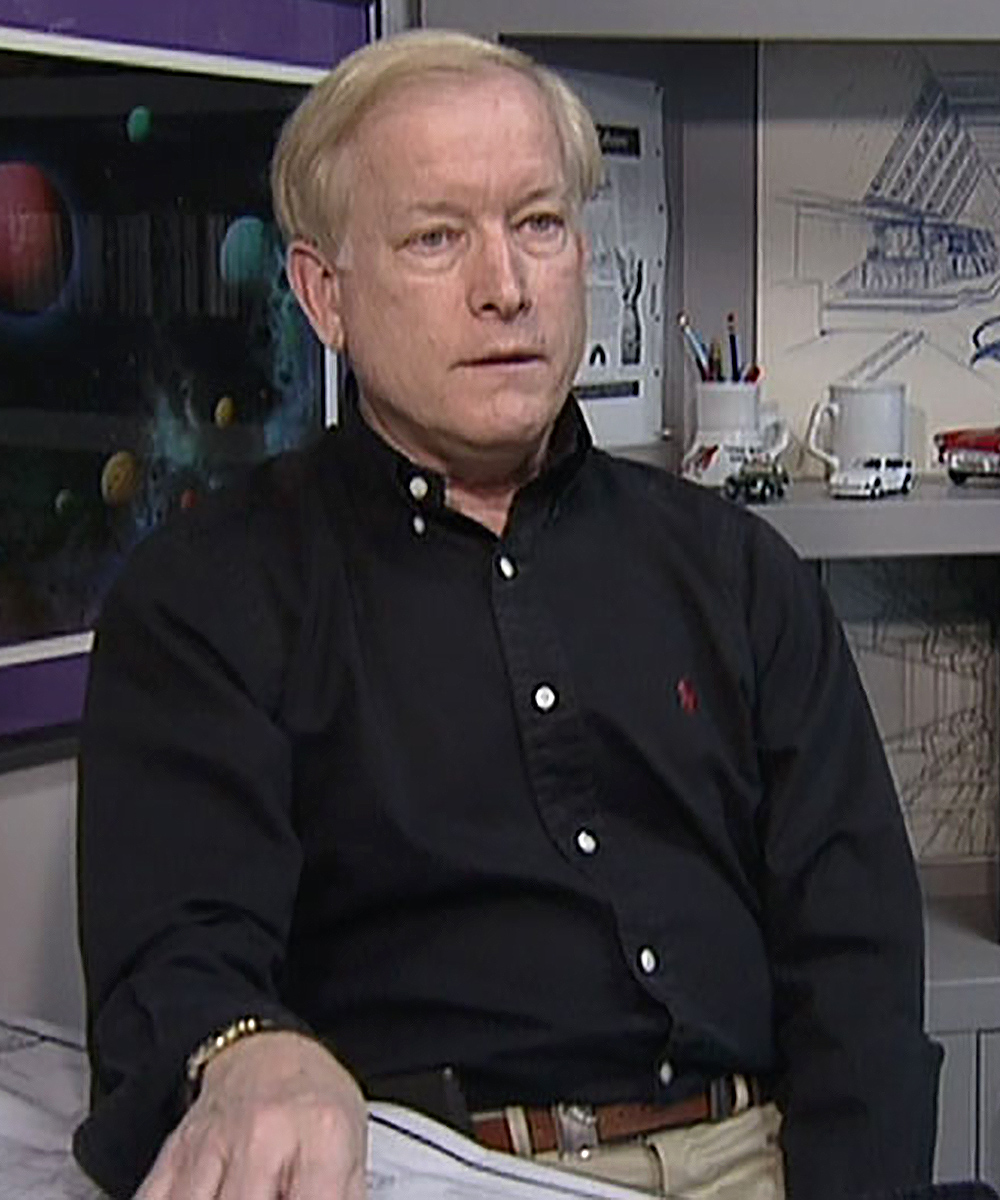
Once the design of Voyager ’s bridge had been finalized, Production Designer Richard James had a fairly good idea of what he wanted to achieve with the rest of the ship’s interiors.
As with the bridge, the challenge for engineering was to produce something fresh without making it unrecognizable to Star Trek fans.
That challenge was made a little easier by the fact that the set would be a redress of The Next Generation ’s.
The Enterprise -D’s engine room had been mostly on one level with a small walkway around the top of the warp core. James wanted to make Voyager ’s more spacious. There was no room to make the set longer, so he concentrated on its height. James conceived the notion of a warp core around which the actors could walk with the camera following them. That would give the set greater depth and motion, and permit new camera angles and perspectives.
Illustrator Jim Martin produced several drawings which gave the set an upper level. That conceptual approach was approved. The second floor would be centered around the warp core: a catwalk permitted actors to be filmed climbing up to this level and moving while there. Adding ladders and a small vertical lift would add more new potential camera shots.

In the final version, James pushed the design further by taking engineering up to a third level.
This emphasis on verticalness also applied to the warp core itself. It had been established on The Next Generation that the core ran almost the entire height of the ship, but on the Enterprise this was not immediately apparent from a visit to engineering. Voyager ’s warp core disappears into a well in the floor and rises far above the actors’ heads, so when visual effects produced footage of the warp core being ejected, the effect was completely believable — viewers knew the core to be real, as they had seen a large part of it for themselves in engineering.

USS Voyager, NCC-74656
The USS Voyager (NCC-74656) was an Intrepid -class Federation starship . It was launched in 2371 and was under the command of Captain Kathryn Janeway . The ship's maximum warp was 9.975, with warp nacelles that pivot upwards while in flight. Voyager featured improved computer systems using both traditional isolinear circuitry and new bio-neural circuitry to improve performance. Voyager also had the capability of landing on the surface of a planet with landing struts.
- 1.1 Commanding Officer (CO) - Captain Kathryn Janeway
- 1.2 Executive Officer (XO) - Commander Chakotay
- 1.3 Chief Tactical Officer / Chief of Security - Lieutenant Commander Tuvok
- 2.1 Chief Engineer - Lieutenant Junior Grade B'Elanna Torres
- 2.2 Pilot - Lieutenant Junior Grade Tom Paris
- 2.3 Operations Manager - Ensign Harry Kim
- 3.1 Head of Astrometrics - Seven of Nine
- 3.2 Chief Medical Officer (CMO) - "The Doctor"
- 3.3 Ambassador to the Delta Quadrant - Neelix
- 3.4 Nurse / Assistant to The Doctor - Kes
- 5 The Search for Voyager
Command Crew
Commanding officer (co) - captain kathryn janeway.
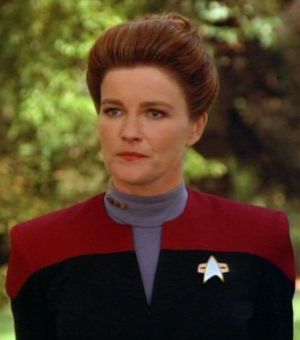
" There are three things to remember about being a starship captain: keep your shirt tucked in, go down with the ship, and never abandon a member of your crew. "
Kathryn Janeway was a 24th century Star Fleet officer, most noted for her service as Captain of the starship USS Voyager . She became the first Federation captain to successfully travel to the Delta Quadrant , encountering dozens of new planets and civilizations. While there, she and her crew also survived numerous encounters with the Borg .
Janeway was well-known for her addiction to coffee . She refused to go a day without a cup of coffee and preferred it completely black, without milk or sugar. Janeway once tried to give up coffee, unsuccessfully. Once, Neelix tried to get her to use Voyager 's food reserves instead of her replicator rations by giving her his "Even better than coffee substitute". Grudgingly, Janeway agreed to try it, but was relieved when the bridge called her just before Neelix was finished pouring it. In an alternate timeline, Janeway gave up coffee in favor of tea later in life.
From 2365 onward, Janeway and Tuvok became close friends, and Janeway found she could always "rely on his insightful and unfailingly logical advice". Tuvok was one of her most trusted friends and advisers, and she discussed all command decisions with him. When Voyager was first stranded in the Delta Quadrant, Janeway met with Maquis cell leader Chakotay. After the Maquis ship was destroyed, Chakotay and Janeway became reluctant allies in the attempt to find missing crewmembers and return to the Alpha Quadrant. Their complicated relationship began first as enemies, then as reluctant ship mates, forming into possible romantic interests, and settling with best friends. Chakotay became Voyager's First Officer , and Janeway relied on Chakotay's innovative tactics in battles, integrating many Maquis techniques.
Executive Officer (XO) - Commander Chakotay
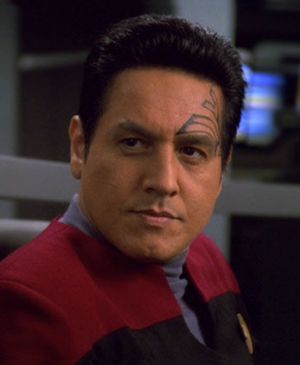
In 2371 , while Star Fleet was trying to capture him in the Badlands , he and his Maquis crew were pulled into the Delta Quadrant and forced to merge with the crew of the Voyager during its journey towards home . Before serving as Voyager' s first officer, he had resigned Star Fleet after years of service in order to join the Maquis to defend his home colony .
Being of Mayan and Native American descent, Chakotay's tribe - mainly because of the intrusion of more technological societies - left Earth hundreds of years ago to find their own home on another planet near the Cardassian border. His father tried to impart his values on Chakotay in many ways, such as taking him to hikes to nearby forested worlds of their ancestors. When his father died, he resigned from Star Fleet to join the Maquis and defend his home colony, continuing the fight in his father's name. He also took the mark, his face tattoo, in order to honor the memory of his father and to signify his Native American heritage.
One of the many reasons he joined Star Fleet was to pursue his interests in anthropology and paleontology. He was fascinated by 20th century Earth, and the early history of space exploration. Since his time at Star Fleet Academy, Chakotay was a fan of boxing. While there, the legendary Boothby helped him train. He occasionally ran a program on the holodeck where he would box a Terrellian with Boothby's assistance. He also said that "boxing helped him relax."
Aboard the Maquis ship Val Jean , Chakotay was close with many of his crew. B'Elanna Torres was Chakotay's engineer and unofficial first officer, and he endorsed her becoming Voyager's Chief Engineer . They had a close, almost sibling-like relationship, though she did not chose him to be her child's godfather because she believed he didn't really know about raising children. (She and Tom chose The Doctor instead.)
Chief Tactical Officer / Chief of Security - Lieutenant Commander Tuvok
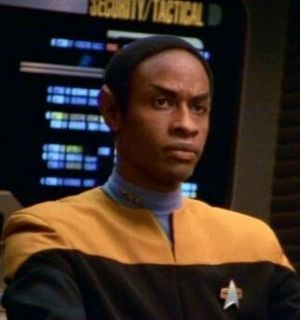
As a teenager, Tuvok rebelled against the Vulcan ideal of logic and reasoning when he fell in love with a Terrellian girl named Jara, the daughter of an ambassador . When she did not return his desperate feelings, Tuvok chose spend several months in isolation studying with a Vulcan master, where he learned to subdue his emotions. Tuvok entered Star Fleet Academy at the age of 25, but found it difficult to fit in. He found the egocentric nature of humans difficult to deal with, but endured it because it was the wish of his parents to enter Star Fleet, and he felt obligated to fulfill their expectations.
In 2371 , he infiltrated the crew of the Maquis raider commanded by a former Star Fleet officer, Chakotay. While hiding from a Cardassian ship in the Badlands , the raider was hit by an energy wave which transported both the Maquis ship and Voyager into the Delta quadrant. Tuvok's status of a spy was revealed when he and Captain Janeway welcomed him back onto the ship.
Tuvok was a devoted parent and husband. Tuvok married T'Pel in 2304 , and later had four children, three sons and a daughter. In 2374 , he learned that his eldest son Sek had a child, named T'Meni after his mother, making him a grandfather. Tuvok was a prize-winning orchid breeder, and used grafting techniques on flowers from both Earth and Vulcan. Tuvok's main pastime was the Vulcan game kal-toh , which he frequently played with Ensign Harry Kim. He also spent his spare time meditating, and instructed various members of the crew in this pursuit over the years.
His closest friend aboard Voyager was Captain Janeway herself, who trusted him completely, and whom he considered the closest thing to family aboard Voyager . Previous to his assignment to Voyager, Tuvok was an instructor at Star Fleet Academy for a period of sixteen years.
Chief Engineer - Lieutenant Junior Grade B'Elanna Torres
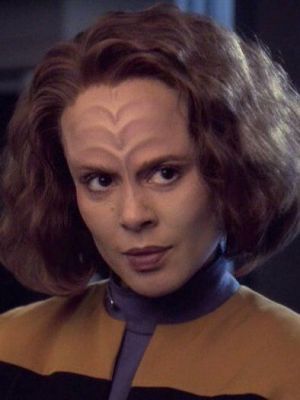
With mother being Klingon and her father being human, B'Elanna was quick to anger and hard to get through to. Though she adored her father as a child, he left B'elanna and her mother, severing any contact. Blaming herself for his leaving, combined with being made fun of for her Klingon head ridges, the young girl began to resent her Klingon heritage. She attended Star Fleet Academy, but felt she did not fit in, continuously getting in fights with teachers and other students. Within two years, she was suspended once and had four disciplinary hearings against her, and she eventually dropped out in 2368 . She met Chakotay and joined the Maquis, finding that fighting Cardassians was the perfect outlet for her anger issues. Being a brilliant Engineer, she was an asset to the Maquis, and even managed to re-program a Cardassian missile for their own use.
Once on Voyager, B'Elanna found more people to fight with, usually the next in line for Chief Engineer, Lieutenant Carey. Once she proved her skills to Captain Janeway and earned her respect, Janeway then made her Chief Engineer over Carey. Often captured by Delta Quadrant species due to her genetic diversity, she continued to feel conflicted about it herself. After marrying Tom Paris and conceiving a child, B'Elanna even went so far as to try and genetically modify her child, to ensure it would not look Klingon, and face the same hardships she did as a child.
B'Elanna was, in part, responsible for Seven of Nine being abandoned by the Borg. During Voyager's first encounter with the Borg, she helped to engineer nanoprobes to use as a weapon against Species 8472 , who had become a threat to both Voyager and the Borg. When Seven, on board Voyager, attempted to assimilate the Star Fleet ship after the Species 8472 threat had been eliminated, B'Elanna created a power surge through Seven that disabled her. This severed Seven's link to the Collective, and the collective left without coming back for the drone.
Pilot - Lieutenant Junior Grade Tom Paris
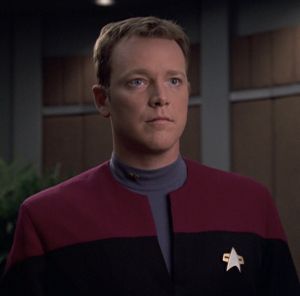
Tom had a love of the ocean and sailing: he planned to join the Federation Naval Patrol until his father pressured him into joining Star Fleet . At the age of eight, his father took him for a trip in an S-class shuttlecraft, and Tom discovered that he loved piloting. He was dismissed from Star Fleet when he tried to cover up a piloting error on his behalf which led to the deaths of three fellow officers. After being expelled from Star Fleet, he joined the Maquis , but was captured on his first mission. Paris was serving time in a Federation Penal Settlement in New Zealand when he received a visit from Captain Janeway. She gave him the opportunity to redeem himself, by participating on a mission to track down the Maquis who were hiding in the Badlands .
On board Voyager, he quickly befriended Harry Kim, and began dalliances with any woman that could stand him for the night. A few serious relationships included Kes, on-and-off with the Delaney sisters , and his eventual wife, B'Elanna . Hobbies included creating and playing in Holodeck programs, playing practical jokes on friends and colleagues, and enjoying old Earth movies, specifically of the science fiction and horror genre.
Paris was the first Star Fleet officer to reach warp 10 . While experimenting with ways for Voyager to quicken her journey, he realized that in simulations, the shuttle was being ripped from the nacelles , not the the other way around. With a minor adjustment, the transwarp threshold could be crossed safely. Despite success in the simulations, the real flight experience caused him to begin to mutate. A disoriented Tom then kidnapped Captain Janeway and took her on a Warp Ten journey, which caused her to mutate as well. When Voyager found them, they had evolved into amphibians. They produced three offspring which the crew left on the planet. Once back on Voyager , The Doctor was able to "de-evolve" them back to their Human forms. Trans-warp travel was then deemed too dangerous and the idea was abandoned.
Operations Manager - Ensign Harry Kim
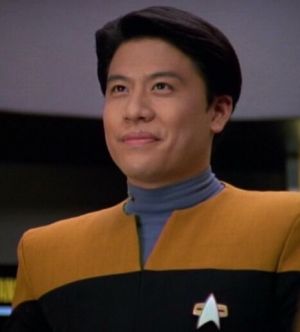
Fresh out of the Academy, being stranded in the Delta Quadrant hit Harry pretty hard. With Voyager being his first field assignment, the Ensign wasn't even sure how to address his Captain. He was quickly befriended by Tom Paris, who, combined with his own rebellious nature, helped Harry instill some confidence in himself over the years. Though he always seemed unlucky in love, Tom continued to set up double-dates between the two men and two female officers known as the Delaney sisters.
Harry's green nature may have labeled him an "easy mark" - he was abducted from The Caretaker , the Vhnori , the Akritirians , and held captive on-board Voyager by the Hirogen . What he lacked in experience, however, he made up for in ingenuity. He and friend Tom Paris built the Delta Flyer , a technologically-advanced shuttle, and its successor, the Delta Flyer Mark 2 , which became an asset to the USS Voyager .
In addition to tagging along on Tom's holodeck programs, Harry enjoyed a variety of his own hobbies. He played music on both the clarinet and saxophone, and enjoyed sports such as volleyball, Parrises squares, and tennis. Perhaps processing an eidetic memory, Harry claims to remember what it was like inside his mother's womb.
Enlisted Crew Members
Head of astrometrics - seven of nine.
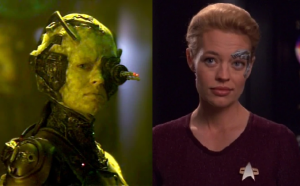
Formerly known as Annika Hansen, the Borg drone known as "Seven of Nine, Tertiary Adjunct of Unimatrix 01" was stranded on Voyager while the two fought against beings only identified as Species 8472 . Having been assimilated at six years old, the Borg Collective was all that she knew. Her parents were exobiologists investigating the existence of the Borg, and in 2356 , all three were assimilated. Naturally, being ripped away from the Borg was traumatic for the person the Voyager crew would come to affectionally call "Seven," which took her some time to come to terms with.
Assisted by Harry Kim, Seven of Nine designed and constructed the ship's astrometrics lab, which used Borg technology to plot routes that trimmed several years off of Voyager's journey towards the Alpha Quadrant. She would go on to assist Harry and Tom in building the Delta Flyer shuttlecrafts. When Neelix's knowledge of the Delta Quadrant waned, Seven was there to step in and inform the Captain what the Borg knew about the species or sector in question. Though not one to usually get along with the crew, Seven did not seem to mind being an outsider, though her lack of empathy did make interpersonal relationships problematic.
Ironically enough, one of Seven's first friends was that of a crewmember's child - Naomi Wildman . The young girl, like Seven, also felt out of place on Voyager, since there was no else like her on board. Naomi, who wanted the made-up job of 'Captain's Assistant,' secretly studied Seven, deciding that the Borg pursuit of perfection would help her achieve her goal of working on the bridge. When Seven discovered Naomi spying on her, she befriended her, admiring her ambition. This may have started Seven's knack for babysitting; in 2376 , Voyager rescued four "immature" Borg drones: children who had been assimilated. Seven became their den mother of sorts, creating a strict timetable for them, and strived to help them assimilate back into a more normal way of life. Three of the four children were either returned or adopted, with the oldest choosing to remain on Voyager.
Chief Medical Officer (CMO) - " The Doctor "
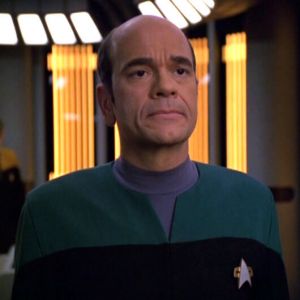
Intended for short-term use only, the Emergency Medical Hologram (EMH) Mark 1 was designed with the attributes of its creator, Dr. Lewis Zimmerman. Programmed with all known medical knowledge, this holographic doctor became much more to the Voyager crew as the years wore on. With limited sentience (holograms cannot feel pain), the EMH experienced prejudice from the Voyager crewmembers, since he was not a "real" Doctor, in the sense that he was not "real." This began to lessen over time, as the Voyager crew, without a medical staff, could not find a replacement doctor, and the EMH was forced into the position of Chief Medical Officer .
Though the Doctor could not feel pain, what he did have was an ego. Most of the crew considered him a computer program, and treated him as such. In turn, he chose to be curt and rude to them, unhappy that he was being used to perform menial medical tasks. Captain Janeway made Tom Paris his nurse, since he had taken a couple courses at the Academy. Once Kes volunteered to replace Tom, relations between the Doctor and the crew improved, with Kes acting as a go-between. During encounters with hostile aliens, the Doctor also proved his worth as a crewmember, and he began to grow as a "person" once allowed to install subroutines. He developed a love of opera, writing, and photography, and became somewhat of a "shutterbug" once he received his mobile emitter , which allowed him to walk freely outside of Sickbay.
Easily his first friend, Kes helped the Doctor come out of his shell, and helped the crew to accept him as a physician and a non-human person. The Doctor became Kes' mentor, as she had developed a great passion for medicine. After being taught social competency by Kes, he tried to teach what he had learned to Seven of Nine, who, like the Doctor, did not exactly fit in with the Voyager crew. He began to develop romantic feelings for Seven, and was crushed when it was clear those feelings would never be returned. Eventually, the crew as a whole were able to overlook his holographic roots, and regarded the Doctor as much as they would any other different species.
Ambassador to the Delta Quadrant - Neelix
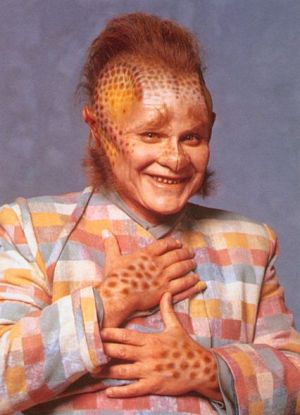
Self-appointed ambassador to the Delta Quadrant for Voyager, the short and spotted male Talaxian certainly stood out on Voyager. Coming aboard shortly after the ship was stranded in the Delta Quadrant, Neelix brought along his girlfriend Kes, and convinced Captain Janeway to keep them on board. Neelix's knowledge of the Delta Quadrant and its politics helped Janeway navigate her way through the unknown space, and the longer they stayed on the Federation ship, the more labels Neelix began to give himself. Afraid that his waning knowledge would cause Janeway to abandon him, Neelix appointed himself Head Chef, Chief Morale Officer and Chief Negotiator. He encouraged Kes to make herself as useful as she could be, as well, and she took up residence in a Cargo Bay, creating a hydroponics lab.
Making friends on Voyager was an easy task for Neelix, even at a few crewmember's chagrin. (He insisted on calling Tuvok "Mr. Vulcan," a name that became a term of endearment between the two.) Though his cooking was not exactly to the crew's liking, he continued to experiment and trying to merge Alpha Quadrant recipes with Delta Quadrant ingredients. He also made a great effort to learn the various cultures of the Voyager crew, helping with birthdays, child-rearing, and Klingon high holidays. He was even appointed godfather to the daughter of Samantha Wildman , a role while he took very seriously.
Coming from an independent merchant background, Neelix was also versed in basic engineering, as well as trading. He shadowed Engineering Chief B'Elanna Torres for a time, trying to learn more complex engineering skills. Commander Chakotay once told Neelix he was "the most versatile member of [the] crew," due to his eagerness to learn new skills. Even Lieutenant Command Tuvok, his reluctant friend, complimented Neelix by saying, "You are perhaps the most resourceful individual I have ever known."
Eventually leaving Voyager, joining a small Talaxian colony taking refuge on an asteroid, Neelix continued his work as a Delta Quadrant Ambassador.
Nurse / Assistant to The Doctor - Kes
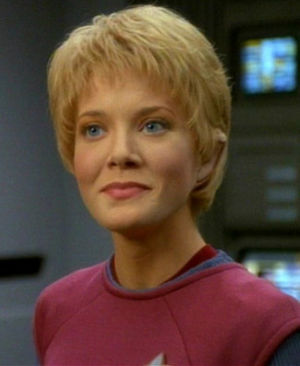
Coming aboard Voyager with her boyfriend Neelix, Kes was one of the first Delta Quadrant species the crew came in contact with. Quickly known for their short life spans, helping the Ocampan people also unfortunately caused Voyager its ticket home. Growing up underground, Kes' curiosity got her captured by the Kazon , and Neelix rescued her with the help of Captain Janeway and her ship. The rescue of Kes and the Voyager / Maquis crew ended with Voyager destroying the Caretaker in order to protect Kes' people from the ones that were capturing Ocampans and torturing them for information.
In addition to truncated life spans, Kes was born with latent psionic abilities, able to sense the presence of others, and could move things with her mind. When she began to lose control of these powers, she received training from her Vulcan friend Tuvok, who taught her to meditate and concentrate. She also looked to the Doctor for training, as her propensity towards gardening had led her to a curiosity towards medicine. She began to split her time between the hydroponics bay and Sickbay, volunteering to become the Doctor's nurse and replace Tom Paris, who resented the job. She also became a go-between for the Doctor and the rest of the crew, who did not treat each other with respect. After helping relations between the Doctor and the Voyager crew, Kes began to branch out and extend her friendship to others.
When Neelix began to show jealousy over her close friendship with Tom Paris, Kes became frustrated, and broke up with him. Confessing to Neelix that she felt they had been growing apart anyway, the two surprisingly stayed close friends. Though the two still cared for each other greatly, they never got back together. Another close friend was Tuvok, whom Kes looked to as a mentor. Though he disapproved of her giggling during meditation sessions, the Vulcan respected her greatly. Captain Janeway also showed a high level of respect towards Kes, despite her youth and inexperience.
After an encounter with Species 8472, Kes' psionic abilities skyrocketed, and she was desperately unable to control them. Rapidly destabilizing at the subatomic level, her condition caused massive damage to Voyager. Fearing for her found-family's lives, she took a shuttle and left the ship. She was able to explore her new state of being, and left the corporeal world behind. As she parted from Voyager, she pushed the ship out of Borg space: 9,500 light years closer to Earth, to thank them for all they had given her.
The USS Voyager was constructed at the Utopia Planitia Fleet Yards orbiting Mars and was launched from Earth Station McKinley on stardate 48038.5 in 2371 . Voyager was the first ship equipped with a Class-9 warp drive. The ship later docked at Deep Space 9 to begin its first mission: to track down the Maquis ship Val Jean , in the Badlands . The mission was only estimated to last a few weeks.
Once in the Badlands, both the Maquis ship and Voyager were hit by a displacement wave created by the Caretaker entity, by which both ships were thrown 70,000 light years from their original location to the outer edge of the Delta Quadrant .
The Search for Voyager
Voyager officially lost contact with Star Fleet on stardate 48307.5, due to being too great a distance away from the Alpha Quadrant .
Star Fleet presumed the Voyager to be destroyed in the Badlands until 2374 , when the ship's EMH was transmitted to the Federation starship USS Prometheus using a Hirogen owned relay station. The ship, at the time, had been taken over by Romulans . The Doctor , with assistance by an EMH Mark II , returned the ship to Star Fleet, and spoke directly to Star Fleet Headquarters to set the record straight.
After the EMH Mark II reported Voyager' s situation, Star Fleet's Communications Research Center set up the Pathfinder Project to find a way to bring back or maintain constant contact with the ship. This project was personally supervised by Admiral Owen Paris , Tom Paris' father, and Kathryn Janeway's old Captain.
In early 2376 , first contact between Star Fleet Command and the Voyager was finally established over the MIDAS array using an artificial micro-wormhole . Although the periods of data transfer were very limited, not only was Star Fleet able to transmit tactical updates to the Voyager crew, but private conversations between Voyager crew members and their relatives in the Alpha Quadrant were also possible.
Navigation menu
Personal tools.
- View source
- View history
- Administration
- Historical Archives
Star Fleet Resources
- Corps of Engineers
- Office of Intelligence
- Medical Command
- Applied Sciences
- Security Command
- Elite Joint Operations
- Tactical Command

Additional Tools
- Recent changes
- Random page
- What links here
- Related changes
- Special pages
- Printable version
- Permanent link
- Page information
- Cite this page
- This page was last edited on 17 February 2024, at 19:06.
- Privacy policy
- About Federation Space - Official Wiki
- Disclaimers
- Mobile view
The USS Voyager NCC-74656 was one of the four of its kind made with newly advanced technology that makes it so advanced from the other previous Starships. Its length measures 344 metres and its width is 130 metres wide. The Voyager is an Intrepid-class Starship. This ship can hold two hundred crew members�though only one hundred and fifty four crew members were recruited when it was first sent into the Badlands to find the Maquis. The crew complement however, was somewhat reduced throughout its journey in the Delta Quadrant due to frequent encounters with hostile aliens or anomalies. To compensate, new recruits were added to the positions needing fulfilling.
There are fifteen decks on the Voyager�Deck One being the top of the saucer and Deck Fifteen being the lowest deck. The Bridge, the center of all operations, is on Deck One. The main source of power to the ship's systems is located on Decks Ten and Eleven being Main Engineering.
Intrepid-class ships are new classes of Starships with advanced technology. It costs relatively less than a Galaxy-class ship. It was built to defend against the Cardassians, Maquis, and the Borg, where the starship is highly maneuverable and was designed for tactical missions.
Some of its features are its bioneural gel packs, systems to increase isolinear processors, variable geometry warp nacelles which allows high-warp flight, and an Emergency Medical Hologram which is also installed into this class to handle health of the crew in emergency situations when the resident Doctor is not available. The EMH has become the ship's main medical personnel when the Voyager's original doctor was killed in action during their encounter with the Caretaker when they first entered the Delta Quadrant.
One feature that other Intrepid-class ships do not have is the (ten times more accurate) advanced Astrometrics Laboratory. The technological advancement to the ship with Borg technology was added during the alliance between the Borg and the crew of Voyager in 2374, stardate 51003.7.
As advanced as the intrepid-class is there are two minor offsets with the ships: they are not designed for families and the replicators are not the most reliable.
But like all Starships, the Voyager includes a set of structural and operation systems�Self-destruct and warp-core ejection, escape pods, jefferies tube network, bussard ramscoops, reaction control systems, docking bays, and fluid handling systems.
The U.S.S Voyager NCC-74656 is an Intrepid-class starship. As is the case with all Starfleet ships, the bridge is on Deck 1, at the top of the command saucer. On the bridge, the captain and her senior officers acquire instrument and sensor data, control command functions, access the main computer, analyze situations, and take any action that seems proper. The bridge is the brain of the ship.
The bridge area is decorated in tones of silver, gray, and chrome. Control surfaces are black, with the usual array of colored pads arranged into a keyboard. Because the sophisticated onboard computer is capable of determining and executing all routine operations, trained crew members are able to control the ship with a minimum of keystrokes. When it is necessary to enter directional information, one may use the circular 'joystick' pad.
- Navigatie Control-Section B-7 - Antimaterie Tanks - Warp Engine Core - Reserve Warp Engine Core - Escape Pod Access
For IEEE Members
Ieee spectrum, follow ieee spectrum, support ieee spectrum, enjoy more free content and benefits by creating an account, saving articles to read later requires an ieee spectrum account, the institute content is only available for members, downloading full pdf issues is exclusive for ieee members, downloading this e-book is exclusive for ieee members, access to spectrum 's digital edition is exclusive for ieee members, following topics is a feature exclusive for ieee members, adding your response to an article requires an ieee spectrum account, create an account to access more content and features on ieee spectrum , including the ability to save articles to read later, download spectrum collections, and participate in conversations with readers and editors. for more exclusive content and features, consider joining ieee ., join the world’s largest professional organization devoted to engineering and applied sciences and get access to all of spectrum’s articles, archives, pdf downloads, and other benefits. learn more →, join the world’s largest professional organization devoted to engineering and applied sciences and get access to this e-book plus all of ieee spectrum’s articles, archives, pdf downloads, and other benefits. learn more →, access thousands of articles — completely free, create an account and get exclusive content and features: save articles, download collections, and talk to tech insiders — all free for full access and benefits, join ieee as a paying member., how nasa is hacking voyager 1 back to life, engineers found space in the geriatric spacecraft’s memory to deal with a stuck bit.

Voyager 1 whizzes through interstellar space at 17 kilometers per second.
On 14 November 2023, NASA’s interstellar space probe Voyager 1 began sending gibberish back to Earth. For five months, the spacecraft transmitted unusable data equivalent to a dial tone.
In March, engineers discovered the cause of the communication snafu: a stuck bit in one of the chips comprising part of Voyager’s onboard memory. The chip contained lines of code used by the flight data subsystem (FDS), one of three computers aboard the spacecraft and the one that is responsible for collecting and packaging data before sending it back to Earth.
JPL engineers sent a command through the Deep Space Network on 18 April to relocate the affected section of code to another part of the spacecraft’s memory, hoping to fix the glitch in the archaic computer system. Roughly 22.5 hours later, the radio signal reached Voyager in interstellar space, and by the following day it was clear the command had worked. Voyager began returning useful data again on 20 April.
NASA engineers managed to diagnose and repair Voyager 1 from 24 billion kilometers away—all while working within the constraints of the vintage technology. “We had some people left that we could rely on [who] could remember working on bits of the hardware,” says project scientist Linda Spilker . “But a lot of it was going back through old memos, like an archeological dig to try and find information on the best way to proceed.”
Minuscule Memory
Voyager 1 and its twin, Voyager 2—which also remains operational—were launched nearly 50 years ago, in 1977, to tour the solar system. Both spacecraft far surpassed their original missions of visiting Jupiter and Saturn, and in 2012, entered interstellar space .
“That mission literally rewrote the textbooks on the solar system,” says Jim Bell , a planetary scientist at Arizona State University and author of a book recounting 40 years of the mission. “We’ve never sent anything out that far, so every bit of data they send back is new.” The 1960s and 1970s technology, on the other hand, is now ancient.
Decades after the tech went out of vogue, the FDS still uses assembly language and 16-bit words . “These are two positively geriatric spacecraft,” says Todd Barber , a propulsion engineer for Voyager. Working to fix the issues, he says, is “like palliative care.”
To first diagnose the issue, NASA’s engineers first tried turning on and off different instruments, says Spilker. When that proved unsuccessful, they initiated a full memory readout of the FDS. “That’s what led to us finding that piece of hardware that had failed and that 256-bit chunk of memory,” she says. In one chip, the engineers found a stuck bit, fixed at the same binary value. It became clear that the chip was irreparable, so the team had to identify and relocate the affected code.
However, no single location was large enough to accommodate the extra 256 bits. “The size of the memory was the biggest challenge in this anomaly,” says Spilker. Voyager’s computers each have a mere 69.63 kilobytes of memory.
To begin fixing the issue, the team searched for corners of Voyager’s memory to place segments of code that would allow for the return of engineering data, which includes information about the status of science instruments and the spacecraft itself. One way the engineers freed up extra space was by identifying processes no longer used. For example, Voyager was programmed with several data modes—the rate at which data is sent back to Earth—because the spacecraft could transmit data much faster when it was closer to Earth. At Jupiter, the spacecraft transmitted data at 115.2 kilobits per second; now, that rate has slowed to 40 bits per second, and faster modes can be overwritten. However, the engineers have to be careful to ensure they don’t delete code that is used by multiple data modes.
Having successfully returned engineering data, the team is working to relocate the rest of the affected code in the coming weeks. “We’re having to look a little harder to find the space and make some key decisions about what to overwrite,” says Spilker. When their work is completed, the Voyager team hopes to return new science data, though unfortunately, all data from the anomaly period was lost.
Built to Last
The cause of the stuck bit is a mystery, but it’s likely the chip either wore out with age or was hit by a highly energetic particle from a cosmic ray. Having entered interstellar space, “Voyager is out bathed in the cosmic rays,” Spilker says. Luckily, the spacecraft was built to take it, with its electronic components shielded from the large amount of radiation present at Jupiter. “That’s serving us quite well now in the interstellar medium.”
When Voyager was built, the 12-year trip to Uranus and Neptune alone was a “seemingly impossible goal for a 1977 launch,” says Barber. The longevity of Voyager is a testament of its engineering, which accounted for many contingencies and added redundancy. The mission also included several firsts, for example, as the first spacecraft with computers able to hold data temporarily using volatile CMOS memory. (An 8-track digital tape recorder onboard stores data when collected at a high rate.)
Importantly, it was also the first mission with a reprogrammable computer. “We take it for granted now,” Bell says, but before Voyager, it wasn’t possible to adjust software in-flight. This capability proved essential when the mission was extended, as well as when issues arise.
Going forward, the Voyager team expects to encounter additional problems in the aging spacecraft—though they hope to make it to the 50-year anniversary before the next one. “With each anomaly, we just learn more about how to work with the spacecraft and are just amazed at the capabilities that the engineers built into it using that 1960s and ’70s technology,” Spilker says. “It’s just amazing.”
- 50 Years Later, This Apollo-Era Antenna Still Talks to Voyager 2 ›
- Voyager 1 Hasn't Really Left The Solar System, But That's OK ›
- Mission Status - Voyager ›
- Voyager 1 ›
Gwendolyn Rak is a contributor to IEEE Spectrum .
I worked with COSMAC and similar rudimentary processors in the early 70’s so was curious to learn how they solved this problem. The nearest it got was “they initiated a full memory readout of the FDS.” But if the telemetry was faulty how did the get the readout?
Disney's Robots Use Rockets to Stick the Landing
Video friday: robot bees, the new shadow hand can take a beating, related stories, satellite radar sharpens ukraine dam collapse questions, the most hackable handheld ham radio yet, faster, more secure photonic chip boosts ai training.
NASA's Voyager 1 spacecraft finally phones home after 5 months of no contact
On Saturday, April 5, Voyager 1 finally "phoned home" and updated its NASA operating team about its health.

NASA's interstellar explorer Voyager 1 is finally communicating with ground control in an understandable way again. On Saturday (April 20), Voyager 1 updated ground control about its health status for the first time in 5 months. While the Voyager 1 spacecraft still isn't sending valid science data back to Earth, it is now returning usable information about the health and operating status of its onboard engineering systems.
Thirty-five years after its launch in 1977, Voyager 1 became the first human-made object to leave the solar system and enter interstellar space . It was followed out of our cosmic quarters by its space-faring sibling, Voyager 2 , six years later in 2018. Voyager 2, thankfully, is still operational and communicating well with Earth.
The two spacecraft remain the only human-made objects exploring space beyond the influence of the sun. However, on Nov. 14, 2023, after 11 years of exploring interstellar space and while sitting a staggering 15 billion miles (24 billion kilometers) from Earth, Voyager 1's binary code — computer language composed of 0s and 1s that it uses to communicate with its flight team at NASA — stopped making sense.
Related: We finally know why NASA's Voyager 1 spacecraft stopped communicating — scientists are working on a fix
In March, NASA's Voyager 1 operating team sent a digital "poke" to the spacecraft, prompting its flight data subsystem (FDS) to send a full memory readout back home.
This memory dump revealed to scientists and engineers that the "glitch" is the result of a corrupted code contained on a single chip representing around 3% of the FDS memory. The loss of this code rendered Voyager 1's science and engineering data unusable.

The NASA team can't physically repair or replace this chip, of course, but what they can do is remotely place the affected code elsewhere in the FDS memory. Though no single section of the memory is large enough to hold this code entirely, the team can slice it into sections and store these chunks separately. To do this, they will also have to adjust the relevant storage sections to ensure the addition of this corrupted code won't cause those areas to stop operating individually, or working together as a whole. In addition to this, NASA staff will also have to ensure any references to the corrupted code's location are updated.
Get the Space.com Newsletter
Breaking space news, the latest updates on rocket launches, skywatching events and more!
— Voyager 2: An iconic spacecraft that's still exploring 45 years on
— NASA's interstellar Voyager probes get software updates beamed from 12 billion miles away
— NASA Voyager 2 spacecraft extends its interstellar science mission for 3 more years
On April 18, 2024, the team began sending the code to its new location in the FDS memory. This was a painstaking process, as a radio signal takes 22.5 hours to traverse the distance between Earth and Voyager 1, and it then takes another 22.5 hours to get a signal back from the craft.
By Saturday (April 20), however, the team confirmed their modification had worked. For the first time in five months, the scientists were able to communicate with Voyager 1 and check its health. Over the next few weeks, the team will work on adjusting the rest of the FDS software and aim to recover the regions of the system that are responsible for packaging and returning vital science data from beyond the limits of the solar system.
Join our Space Forums to keep talking space on the latest missions, night sky and more! And if you have a news tip, correction or comment, let us know at: [email protected].

Robert Lea is a science journalist in the U.K. whose articles have been published in Physics World, New Scientist, Astronomy Magazine, All About Space, Newsweek and ZME Science. He also writes about science communication for Elsevier and the European Journal of Physics. Rob holds a bachelor of science degree in physics and astronomy from the U.K.’s Open University. Follow him on Twitter @sciencef1rst.
China launches 4 satellites on 1st flight of new Long March 6C rocket (video)
SpaceX launches 20 Starlink satellites from California (video)
The stormy sun erupts with its biggest solar flare yet from a massive sunspot — and it's still crackling (video)
- Robb62 'V'ger must contact the creator. Reply
- Holy HannaH! Couldn't help but think that "repair" sounded extremely similar to the mechanics of DNA and the evolution of life. Reply
- Torbjorn Larsson *Applause* indeed, thanks to the Voyager teams for the hard work! Reply
- SpaceSpinner I notice that the article says that it has been in space for 35 years. Either I have gone back in time 10 years, or their AI is off by 10 years. V-*ger has been captured! Reply
Admin said: On Saturday, April 5, Voyager 1 finally "phoned home" and updated its NASA operating team about its health. The interstellar explorer is back in touch after five months of sending back nonsense data. NASA's Voyager 1 spacecraft finally phones home after 5 months of no contact : Read more
evw said: I'm incredibly grateful for the persistence and dedication of the Voyagers' teams and for the amazing accomplishments that have kept these two spacecrafts operational so many years beyond their expected lifetimes. V-1 was launched when I was 25 years young; I was nearly delirious with joy. Exploring the physical universe captivated my attention while I was in elementary school and has kept me mesmerized since. I'm very emotional writing this note, thinking about what amounts to a miracle of technology and longevity in my eyes. BRAVO!!! THANK YOU EVERYONE PAST & PRESENT!!!
- EBairead I presume it's Fortran. Well done all. Reply
SpaceSpinner said: I notice that the article says that it has been in space for 35 years. Either I have gone back in time 10 years, or their AI is off by 10 years. V-*ger has been captured!
EBairead said: I presume it's Fortran. Well done all.
- View All 13 Comments
Most Popular
- 2 Houston, we have an encore: ISS virtual reality experience 'The Infinite' returns
- 3 Total solar eclipse 2027: A complete guide to the 'eclipse of the century'
- 4 This Week In Space podcast: Episode 110 — Voyager 1's Brush with Silence
- 5 DARPA's autonomous 'Manta Ray' drone can glide through ocean depths undetected
Inside NASA's 5-month fight to save the Voyager 1 mission in interstellar space

After working for five months to re-establish communication with the farthest-flung human-made object in existence, NASA announced this week that the Voyager 1 probe had finally phoned home.
For the engineers and scientists who work on NASA’s longest-operating mission in space, it was a moment of joy and intense relief.
“That Saturday morning, we all came in, we’re sitting around boxes of doughnuts and waiting for the data to come back from Voyager,” said Linda Spilker, the project scientist for the Voyager 1 mission at NASA’s Jet Propulsion Laboratory in Pasadena, California. “We knew exactly what time it was going to happen, and it got really quiet and everybody just sat there and they’re looking at the screen.”
When at long last the spacecraft returned the agency’s call, Spilker said the room erupted in celebration.
“There were cheers, people raising their hands,” she said. “And a sense of relief, too — that OK, after all this hard work and going from barely being able to have a signal coming from Voyager to being in communication again, that was a tremendous relief and a great feeling.”

The problem with Voyager 1 was first detected in November . At the time, NASA said it was still in contact with the spacecraft and could see that it was receiving signals from Earth. But what was being relayed back to mission controllers — including science data and information about the health of the probe and its various systems — was garbled and unreadable.
That kicked off a monthslong push to identify what had gone wrong and try to save the Voyager 1 mission.
Spilker said she and her colleagues stayed hopeful and optimistic, but the team faced enormous challenges. For one, engineers were trying to troubleshoot a spacecraft traveling in interstellar space , more than 15 billion miles away — the ultimate long-distance call.
“With Voyager 1, it takes 22 1/2 hours to get the signal up and 22 1/2 hours to get the signal back, so we’d get the commands ready, send them up, and then like two days later, you’d get the answer if it had worked or not,” Spilker said.

The team eventually determined that the issue stemmed from one of the spacecraft’s three onboard computers. Spilker said a hardware failure, perhaps as a result of age or because it was hit by radiation, likely messed up a small section of code in the memory of the computer. The glitch meant Voyager 1 was unable to send coherent updates about its health and science observations.
NASA engineers determined that they would not be able to repair the chip where the mangled software is stored. And the bad code was also too large for Voyager 1's computer to store both it and any newly uploaded instructions. Because the technology aboard Voyager 1 dates back to the 1960s and 1970s, the computer’s memory pales in comparison to any modern smartphone. Spilker said it’s roughly equivalent to the amount of memory in an electronic car key.
The team found a workaround, however: They could divide up the code into smaller parts and store them in different areas of the computer’s memory. Then, they could reprogram the section that needed fixing while ensuring that the entire system still worked cohesively.
That was a feat, because the longevity of the Voyager mission means there are no working test beds or simulators here on Earth to test the new bits of code before they are sent to the spacecraft.
“There were three different people looking through line by line of the patch of the code we were going to send up, looking for anything that they had missed,” Spilker said. “And so it was sort of an eyes-only check of the software that we sent up.”
The hard work paid off.
NASA reported the happy development Monday, writing in a post on X : “Sounding a little more like yourself, #Voyager1.” The spacecraft’s own social media account responded , saying, “Hi, it’s me.”
So far, the team has determined that Voyager 1 is healthy and operating normally. Spilker said the probe’s scientific instruments are on and appear to be working, but it will take some time for Voyager 1 to resume sending back science data.
Voyager 1 and its twin, the Voyager 2 probe, each launched in 1977 on missions to study the outer solar system. As it sped through the cosmos, Voyager 1 flew by Jupiter and Saturn, studying the planets’ moons up close and snapping images along the way.
Voyager 2, which is 12.6 billion miles away, had close encounters with Jupiter, Saturn, Uranus and Neptune and continues to operate as normal.
In 2012, Voyager 1 ventured beyond the solar system , becoming the first human-made object to enter interstellar space, or the space between stars. Voyager 2 followed suit in 2018.
Spilker, who first began working on the Voyager missions when she graduated college in 1977, said the missions could last into the 2030s. Eventually, though, the probes will run out of power or their components will simply be too old to continue operating.
Spilker said it will be tough to finally close out the missions someday, but Voyager 1 and 2 will live on as “our silent ambassadors.”
Both probes carry time capsules with them — messages on gold-plated copper disks that are collectively known as The Golden Record . The disks contain images and sounds that represent life on Earth and humanity’s culture, including snippets of music, animal sounds, laughter and recorded greetings in different languages. The idea is for the probes to carry the messages until they are possibly found by spacefarers in the distant future.
“Maybe in 40,000 years or so, they will be getting relatively close to another star,” Spilker said, “and they could be found at that point.”
Denise Chow is a reporter for NBC News Science focused on general science and climate change.

Navy's USS Boxer Faces Engineering Hurdles, Undergoes Rudder Repairs
T he USS Boxer (LHD-4), a mainstay of the U.S. Navy’s amphibious warfare fleet, faces a challenging setback due to a critical rudder failure, necessitating an underwater repair process at Naval Station San Diego, California. In a bid to return to operational status, the Navy has opted for a novel in-water repair strategy that will likely see the warship rejoin its deployment potentially by this summer.
The starboard rudder issue, which came to light following the Boxer’s departure for deployment on April 1, was deemed most efficiently tackled via waterborne repairs. “The issue is the ship’s starboard rudder and roller bearing system. A series of inspections and assessments determined a waterborne repair is the most efficient way to execute maintenance and repairs,” according to a Naval Surface Force statement provided to the press.
The Boxer’s saga of mechanical failures dates to an extensive modernization period that culminated in 2022. Since then, the ship has been beleaguered by engineering woes. The gravity of these challenges drew comments from high-ranking naval officials, with Vice Chief of Naval Operations Adm. Jim Kilby acknowledging to a House Armed Services subcommittee that “our amphib ships – the big decks in particular with steam plants – are having larger growth work than most of our ships, and it’s a challenge because of the availability of parts, artisans, etc.”
Amidst multiple command investigations revealing negligence and maintenance deficiencies among the crew, the Navy has pinpointed contractor performance and quality assurance issues as significant contributors to deployment delays. This reflects a broader problem within the Navy’s maintenance system.
The in-water repair decision aligns with the lack of availability of San Diego’s dry docks and the impracticality of alternative arrangements, such as moving the ship to another port which would necessitate the removal of the ship’s mast to navigate under a bridge over the Willamette River.
While the USS Boxer’s engineering department undergoes scrutiny, the vessel’s future remains a focus of intense interest, especially considering the Boxer is the flagship of the Amphibious Ready Group that includes USS Somerset (LPD-25) and USS Harpers Ferry (LSD-49), which are currently operating in the South China Sea.
As the Navy proceeds with the investigation to pinpoint the root cause of the rudder failure, whether due to “materials, parts or a faulty installation,” the commitment to a swift and effective resolution is apparent. With other ships in the group taking part in critical exercises such as the Balikatan 2024 with the Armed Forces of the Philippines, the Boxer’s role in the strategic activities in the region underscores the urgency of her repairs.
Relevant articles:
– Navy Elects to Fix USS Boxer Rudder with Divers, Repair Could Take 2 Months , USNI News
– USS Boxer Back in San Diego for Repairs, Pacific Deployment Stalled , USNI News
– USS Boxer’s Breakdown May Take Two Months to Fix Without Drydock , The Maritime Executive
– USS Boxer makes U-turn for repairs on long-delayed, short-lived Indo-Pacific tour , Stars and Stripes
![The USS Boxer (LHD-4), a mainstay of the U.S. Navy̵ […] The USS Boxer (LHD-4), a mainstay of the U.S. Navy̵ […]](https://img-s-msn-com.akamaized.net/tenant/amp/entityid/BB1lS8Rx.img?w=768&h=512&m=6)

Current time by city
For example, New York
Current time by country
For example, Japan
Time difference
For example, London
For example, Dubai
Coordinates
For example, Hong Kong
For example, Delhi
For example, Sydney
Geographic coordinates of Elektrostal, Moscow Oblast, Russia
City coordinates
Coordinates of Elektrostal in decimal degrees
Coordinates of elektrostal in degrees and decimal minutes, utm coordinates of elektrostal, geographic coordinate systems.
WGS 84 coordinate reference system is the latest revision of the World Geodetic System, which is used in mapping and navigation, including GPS satellite navigation system (the Global Positioning System).
Geographic coordinates (latitude and longitude) define a position on the Earth’s surface. Coordinates are angular units. The canonical form of latitude and longitude representation uses degrees (°), minutes (′), and seconds (″). GPS systems widely use coordinates in degrees and decimal minutes, or in decimal degrees.
Latitude varies from −90° to 90°. The latitude of the Equator is 0°; the latitude of the South Pole is −90°; the latitude of the North Pole is 90°. Positive latitude values correspond to the geographic locations north of the Equator (abbrev. N). Negative latitude values correspond to the geographic locations south of the Equator (abbrev. S).
Longitude is counted from the prime meridian ( IERS Reference Meridian for WGS 84) and varies from −180° to 180°. Positive longitude values correspond to the geographic locations east of the prime meridian (abbrev. E). Negative longitude values correspond to the geographic locations west of the prime meridian (abbrev. W).
UTM or Universal Transverse Mercator coordinate system divides the Earth’s surface into 60 longitudinal zones. The coordinates of a location within each zone are defined as a planar coordinate pair related to the intersection of the equator and the zone’s central meridian, and measured in meters.
Elevation above sea level is a measure of a geographic location’s height. We are using the global digital elevation model GTOPO30 .
Elektrostal , Moscow Oblast, Russia

Paramount Stage 9
- View history

Paramount logo found at the intro of many Star Trek films
Paramount Stage 9 is located on the Paramount Pictures lot in Hollywood, California.
Stage 9 was used in most Star Trek productions including the first seven feature films , Star Trek: The Next Generation and Star Trek: Voyager .
It was used through the four-year run of Star Trek: Enterprise and also housed sets for the 2009 film Star Trek .
- 1 1977-1986
- 2.1 Break-in
- 3 1994-2001
- 4 2001-2005
- 6 Productions
- 8 External links
1977-1986 [ ]
During its 1977 pre-production, sets for Star Trek: Phase II were slated for construction and permanent use on Stage 9.

Main bridge from Star Trek VI: The Undiscovered Country

Main engineering from Star Trek: The Motion Picture
Most of Phase II 's sets were completed when that series gave way to production of Star Trek: The Motion Picture , at which point they were modified and expanded for use in the feature film.
Stage 9 contained the primary interiors of the refit Enterprise and the USS Enterprise -A including the main bridge , transporter room , sickbay , corridor complex , Captain Kirk's cabin , and engineering .
Paramount Stage 8 housed the rec deck of the Enterprise , seen in The Motion Picture .
After the first feature, the dilithium chamber was added to engineering for the climax of Star Trek II: The Wrath of Khan . The sets remained mostly unchanged for Star Trek III: The Search for Spock .
The stage was used through Star Trek IV: The Voyage Home for Bird-of-Prey and Enterprise -A interiors, until it was taken over for permanent use in Star Trek: The Next Generation .
1987-1994 [ ]
In 1987 , with the start of Star Trek: The Next Generation , the sets on Stage 9 underwent modifications to become the USS Enterprise -D , the most drastic of which being the overhaul of the engineering and main bridge sets – the latter becoming the battle bridge .
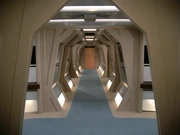
Corridors from Star Trek: The Next Generation
Edward K. Milkis and Robert H. Justman viewed the existing film sets for the first time in October 1986 to determine what could be reused for the new series. They found the sets in poor shape due to damage caused by cats living on the stage. ( Star Trek: The Next Generation Companion (3rd ed., p. 8))
With new bridge and living quarters sets being constructed on Stage 6 for season one , Stage 9 contained the Enterprise -D's engineering, sickbay, crew quarters, transporter room, shuttlebay , and corridor complex sets. Other sets included the fullsize shuttlecraft mockups and interiors.
Sickbay doubled as the observation lounge : the observation lounge windows were covered with carpet during the sickbay scenes. A new conference lounge was built on Stage 8 for season two . ( Star Trek: The Next Generation Companion (3rd ed., pp. 10 & 65))
Space across from the transporter room was saved for swing sets such as Troi's office and the battle bridge doubled as Data 's lab and other locations, on and off the Enterprise .
Stage 8 housed the remaining Enterprise -D interiors used post TNG Season 2 and Generations .
Over the seven season run of TNG, the sets were refined – the corridors were expanded for longer tracking shots – but remained mostly unchanged even through the production of the seventh feature, Star Trek Generations .
The vast TNG interior sets were redressed for the final two original series movies, Star Trek V: The Final Frontier and Star Trek VI: The Undiscovered Country in 1988 and 1991 respectively.
Temporary sets filmed on Stage 9 included the Rutian plaza in the episode " The High Ground " as well as scenes aboard the Talarian observation craft in the episode " Suddenly Human ", filmed on 27 July 1990 . Stage 9 also housed the workout room seen in episodes such as " Clues ", filmed on 29 November 1990 . The Tamarian bridge seen in the episode " Darmok " was built on Stage 9, filmed on 24 July 1991 and 25 July 1991 .
Break-in [ ]
On 10 January 2007 , a user on the video sharing website YouTube posted four videos entitled Stage 9 Interlopers
Consisting of four parts, the videos were shot on the night of 10 March 1988 by (at least) two fervent Star Trek fans who had broken onto the Paramount lot. Wandering through the darkened sets of Star Trek: The Next Generation (circa season one), the fans were able to light select parts of the sets, including most of the ship's display terminals and part of the warp core . Dressed in a makeshift Starfleet uniform (with white socks), one of the fans acted as the host of what was likely intended to be a homemade documentary – at one point climbing onto a sickbay biobed , then accidentally knocking it to the floor. Taking still photographs of the various "working" control panels, the fans can be heard discussing ways of removing set pieces from the stage.
According the YouTube user's description of the videos, when the fans were caught, they dropped the camcorder containing the footage and fled. [1]
1994-2001 [ ]
After their use in Generations , the sets on Stage 9 underwent yet another revamp for their debut as the USS Voyager . ( Star Trek: The Next Generation Companion (3rd ed., p. 321)) Richard James used his TNG experience and designed the Voyager sets to be easier to film than previous ones. ( A Vision of the Future - Star Trek: Voyager , page 91)
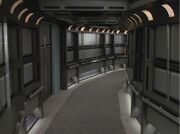
Corridors from Star Trek: Voyager
As on TNG , Stage 9 housed engineering, sickbay, transporter room, junior officers' quarters, the corridor complex, and the shuttlebay/cargo bay/holodeck. A large science lab was eventually constructed here as well. ( A Vision of the Future - Star Trek: Voyager , page 83)
While most sets retained their general positions, the Voyager engineering set was dramatically expanded, gaining a large second level. In its previous incarnation, engineering stood as part of the corridor complex and was often modified to represent a junction or living area. The revamp for VOY corrected this problem by making engineering its own compartment – a permanent standing set.
Sickbay was joined by a small biomedical laboratory for the second season , to the consternation of some crew members who felt the space would be better utilized for production storage. ( A Vision of the Future - Star Trek: Voyager , page 91)
Stage 8 housed the remaining Voyager interiors used in VOY.
In 1996 , Voyager 's sickbay was modified for use in Star Trek: First Contact and again in 1998 for Star Trek: Insurrection . The entrance to main engineering also represented the USS Enterprise -E 's library, while the transporter room was also reused and slightly redressed.
For the second season episode " Resistance ", Stage 9 housed the set of Caylem 's shelter. The scenes were filmed on Monday 25 September 1995 and Tuesday 26 September 1995 .
On Monday 2 April 2001 , Stage 9 housed the sets for the cave interiors, jungle sets, and rocky side areas during second unit for the seventh season episode " Natural Law ".
The science lab set was the first standing Voyager set on Stage 9 to be demolished, on 22 March 2001 . Tuvok's hospital room from " Endgame " was constructed in its place. Engineering was dismantled over 29 March 2001 to 5 April 2001 . Demolition started on the cargo bay set on 5 April 2001 as well. ( Star Trek: The Magazine Volume 2, Issue 4 , pages 69-71)
2001-2005 [ ]
In 2001 , following the end of Voyager 's final season , all of the sets in Stage 9 were permanently removed.
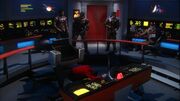
Star Trek: Enterprise , " In a Mirror, Darkly "
Instead of being home to the interiors of Enterprise NX-01 for Enterprise , Stage 9 housed only that series' cave set and various swing sets. Paramount Stages 18 and 8 housed all of the NX-01 interiors used in Enterprise .
Stage 9 housed the following sets:
- Captain's mess ( ENT : " Terra Nova ")
- Terra Nova underground tunnels , caves , gutting room , and well ( ENT : " Terra Nova ")
- Underground catacombs , stairwell , archway, meditation room, and reliquary at the monastery at P'Jem ( ENT : " The Andorian Incident ")
- Surface of Archer's Comet ( ENT : " Breaking the Ice ")
- Shuttlepod 1 interior, Akaali forest clearing , and basement mine control room and stairwell ( ENT : " Civilization ")
- Risan bistro, nightclub, and basement under the nightclub and Hoshi Sato's apartment ( ENT : " Two Days and Two Nights ")
- Rura Penthe ( ENT : " Judgment ")
- Bridge of the USS Defiant ( ENT : " In a Mirror, Darkly ", " In a Mirror, Darkly, Part II ")
- Rigel X ( ENT : " These Are the Voyages... ")
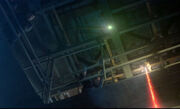
Stage 9 roof in " These Are the Voyages... "
The ceiling of the stage was actually seen in the scenes of " These Are the Voyages... ", as it was deemed a good fit for the interior of the complex.
Stage 9 was home to the mines of Remus in 2002 for the filming of scenes from Star Trek Nemesis .
Following the cancellation of Enterprise in 2005 , Stage 9 was, for the first time in many years, put into use in non- Star Trek productions.
According to a May 2007 news item from The Trek Movie Report website, J.J. Abrams ' 2009 film, Star Trek , was – in part – filmed on Paramount's Stage 9.
Set construction was scheduled to take place in July 2007 , utilizing other "historic" Star Trek sound stages including Stages 8, 11 , 14 , 15 , and 18. [2]
Productions [ ]
- Star Trek: Phase II
- Star Trek: The Motion Picture
- Star Trek II: The Wrath of Khan
- Star Trek III: The Search for Spock
- Star Trek IV: The Voyage Home
- Star Trek: The Next Generation
- Star Trek V: The Final Frontier
- Star Trek VI: The Undiscovered Country
- Star Trek Generations
- " Caretaker " ( Val Jean Int., Transporter room, corridors, Kazon bridge, Cardassian bridge, Neelix' junk ship, Neelix' Quarters and bathroom, sickbay, Mark's House, Engineering)
- Star Trek: First Contact
- Star Trek: Insurrection
- Star Trek: Enterprise
- Star Trek Nemesis
- Star Trek ( 2009 )
Sources [ ]
- Judith and Garfield Reeves-Stevens , Star Trek Phase II: The Lost Series
- Stephen Edward Poe , A Vision of the Future - Star Trek: Voyager
- Michael and Denise Okuda , Star Trek Nemesis (Special Edition) text commentary
- Michael Okuda, A Brief History of Paramount Stages 8 & 9 , StarTrek.com [3] (X)
External links [ ]
- Paramount Pictures – official website
- StarTrek.com , the official Star Trek website
- 3 Erigah (episode)

COMMENTS
They added to his challenge by deciding Voyager should be able to land on a planetary surface. That meant the ship needed deployable landing gear. By the spring of 1994, something resembling the Voyager we know had emerged. The slightly angular dart front had been smoothed off and nestled into the engineering section — still assuming a ...
The USS Voyager (NCC-74656) was a 24th century Federation Intrepid-class starship operated by Starfleet from 2371 to 2378. One of the most storied starships in the history of Starfleet, Voyager was famous for completing an unscheduled seven-year journey across the Delta Quadrant, the first successful exploration of that quadrant by the Federation, as well as numerous technological innovations ...
Voyager's computer core installation took place on Stardate 47833.9; it was fast-tracked to follow the U.S.S. Intrepid NCC-74600 and the U.S.S. Bellerophon NCC-74705 by only three months. With assembly and internal systems checks completed, the official launching occurred at Earth Station McKinley on Stardate 48039.7, though primary construction was completed at Utopia Planitia Fleet Yards.
USS Voyager (NCC-74656) is the fictional Intrepid-class starship which is the primary setting of the science fiction television series Star Trek: Voyager.It is commanded by Captain Kathryn Janeway. Voyager was designed by Star Trek: Voyager production designer Richard D. James and illustrator Rick Sternbach.Most of the ship's on-screen appearances are computer-generated imagery (CGI), although ...
Richard D. James in 1994. Once the design of Voyager's bridge had been finalized, Production Designer Richard James had a fairly good idea of what he wanted to achieve with the rest of the ship's interiors.. As with the bridge, the challenge for engineering was to produce something fresh without making it unrecognizable to Star Trek fans.. That challenge was made a little easier by the ...
The USS Voyager (NCC-74656) was an Intrepid -class Federation starship. It was launched in 2371 and was under the command of Captain Kathryn Janeway. The ship's maximum warp was 9.975, with warp nacelles that pivot upwards while in flight. Voyager featured improved computer systems using both traditional isolinear circuitry and new bio-neural ...
Early references came from the runabout design and others of the saucer-engineering hell-nacelles variety, as well as from nature. Starship designs have often been inspired by fast, sleek animals, and the USS Voyager NCC-74656 began in embryonic form by taking on characteristics of an Ocra whale, manta ray, and a few different birds.
The USS Voyager NCC-74656 was one of the four of its kind made with newly advanced technology that makes it so advanced from the other previous Starships. Its length measures 344 metres and its width is 130 metres wide. The Voyager is an Intrepid-class Starship. This ship can hold two hundred crew members—though only one hundred and fifty ...
An Intrepid-class starship such as USS Voyager normally had a complement of approximately 150 crew. When Voyager left drydock, its crew complement was 153. During the tumultuous voyage to and through the Delta Quadrant, many of those were lost. But there were also several new crewmembers taken on, first from Chakotay's Maquis and the Ocampa sector, and later from the Borg and the USS Equinox ...
Voyager in drydock at the Utopia Planitia Fleet Yards. Development and construction of the Intrepid-class occurred at the Utopia Planitia Fleet Yards with the class entering service by 2370.The second ship, USS Voyager, was commissioned in 2371.It was the first ship to test the class 9 warp drive in deep space. At the time of its introduction, the Intrepid-class was considered to be the most ...
USS Voyager engineering officer, operations officer, security officer, helmsman: Rank: Lieutenant junior grade: Ayala was played by Tarik Ergin. He appears in the background of almost every episode, more than any other "named extra". He speaks, briefly, in a handful of episodes. He is the only character other than the regulars to appear in both ...
Star Trek: Voyager is an American science fiction television series created by Rick Berman, Michael Piller and Jeri Taylor.It originally aired from January 16, 1995, to May 23, 2001, on UPN, with 172 episodes over seven seasons.It is the fifth series in the Star Trek franchise. Set in the 24th century, when Earth is part of a United Federation of Planets, it follows the adventures of the ...
Come with me as I struggle to find my way to Engineering on the USS Voyager. Higher textures from the Elite Force Grafic Overhaulhttp://starfleetstudios.com
NASA/JPL. On 14 November 2023, NASA's interstellar space probe Voyager 1 began sending gibberish back to Earth. For five months, the spacecraft transmitted unusable data equivalent to a dial ...
Deck # Primary Hull Deck # Engineering Hull 1 Bridge, ready room, conference room, escape pod access, aft bridge airlock, upper sensor platform : 2 Officers' mess, officers' and VIP quarters, labs and storage, sensor gear, escape pod access : 3 Captain's quarters, officers' and VIP quarters, photon torpedo trackers 4 Aft torpedo launchers, transporter rooms 1 and 2, phaser maintenance, sensor ...
In 1979, Alan Cummings, a scientist working on NASA's unprecedented Voyager mission, entered a Caltech room in Pasadena, California, and saw an unusual, alien world projected on a screen. The ...
On Saturday, April 5, Voyager 1 finally "phoned home" and updated its NASA operating team about its health. The interstellar explorer is back in touch after five months of sending back nonsense data.
Inside NASA's 5-month fight to save the Voyager 1 mission in interstellar space. The Voyager 1 probe is the most distant human-made object in existence. After a major effort to restore ...
Robert Picardo, Roxann Dawson, Ethan Phillips, Tim Russ at a Voyager panel in 2009. Star Trek: Voyager is an American science fiction television series that debuted on UPN on January 16, 1995, and ran for seven seasons until May 23, 2001. The show was the fourth live-action series in the Star Trek franchise. This is a list of actors who have appeared on Star Trek: Voyager
The USS Boxer (LHD-4), a mainstay of the U.S. Navy's amphibious warfare fleet, faces a challenging setback due to a critical rudder failure, necessitating an underwater repair process at Naval ...
Engineering, main engineering, or the engine room (the reactor pit in Klingonese), was the location from which the ship's main power systems were controlled. Engineering was the primary assignment of engineers and chief engineers. In the late 20th century, nuclear vessels of the United States Navy designated their engine room as the main machine room, or MMR. A ship, like the aircraft carrier ...
Elektrostal , lit: Electric and Сталь , lit: Steel) is a city in Moscow Oblast, Russia, located 58 kilometers east of Moscow. Population: 155,196 ; 146,294 ...
Elektrostal is a city in Moscow Oblast, Russia, located 58 kilometers east of Moscow. Elektrostal has about 158,000 residents. Mapcarta, the open map.
Although most engineering functions were controlled from the engine room, engineering stations on the bridge of starships enabled monitoring and control by the chief engineer. These bridge stations were often identified as Engineering I and Engineering II. (Star Trek: The Original Series, Star Trek: The Animated Series, Star Trek: The Next Generation, Star Trek: Voyager, Star Trek: Enterprise ...
Moscow Oblast (Russian: Московская область, romanized: Moskovskaya oblast, IPA: [mɐˈskofskəjə ˈobləsʲtʲ], informally known as Подмосковье, Podmoskovye, IPA: [pədmɐˈskovʲjə]) is a federal subject of Russia (an oblast).With a population of 8,524,665 (2021 Census) living in an area of 44,300 square kilometers (17,100 sq mi), it is one of the most densely ...
Geographic coordinates of Elektrostal, Moscow Oblast, Russia in WGS 84 coordinate system which is a standard in cartography, geodesy, and navigation, including Global Positioning System (GPS). Latitude of Elektrostal, longitude of Elektrostal, elevation above sea level of Elektrostal.
Stage 8 housed the remaining Voyager interiors used in VOY. In 1996, Voyager's sickbay was modified for use in Star Trek: First Contact and again in 1998 for Star Trek: Insurrection. The entrance to main engineering also represented the USS Enterprise-E's library, while the transporter room was also reused and slightly redressed.